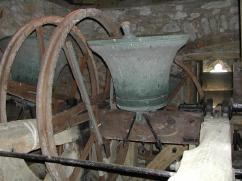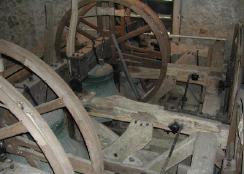Rehanging and augmentation
The following is part of the text of an article which appeared in The Ringing World in October 2005.
Brasted project comes of age
By early 2003 the old six were getting difficult to handle, and they weren't that melodious either. They had been around for over 120 years and their fittings had been in use for over 70 years. The bells, we felt, should be OK for quite a while yet, but something had to be done about the fittings, which really were past their sell-by date and needed replacing. If some repair work was not done fairly soon the bells would get more and more difficult to ring (the teaching of beginners was already not as easy as we would have liked) and it could be that all ringing might eventually have to cease. We could live with the ancient frame — they knew how to build bellframes in those days, although it now would need extra tierods to make it more rigid.
At the same time, and this was the really exciting bit, we decided to add two new bells to give St Martin's a full octave for the first time. After all, we originally had had four bells, and six from 1730, so we figured it must be time to acquire a real eight in 2003. While we were on this spending spree we decided that we might as well go the whole hog and retune the old six too. However, new bells and fittings don't come specially cheaply, and the full cost of the operation was likely to be around £57,000.
So where did all the money come from? Well, the KCACR, in addition to providing training for ringers in Kent, has a very healthy bell restoration fund and agreed to make a grant of some £4,000 towards the project. But the Association doesn't only help financially — it has a very keen group of volunteers (one a Brasted ringer) who help the bell foundry by taking the bells out of the tower and by assisting the foundry's staff with the assembly of the new installation. This would probably save us over £6,000. Durtnell's, a local building firm founded in 1591, only 21 years after Whitechapel, agreed to transport the bells for free, saving another £600. (It was quite reassuring that two companies involved with our work had between them nearly 900 years' experience.) By Easter 2003 we already had promises of funding from people who rang at Brasted — indeed one regular ringing visitor's family offered to pay for one of the new bells, and a local ringer gave another £5,000. So it came about that by the middle of 2003 we had just over £26,000 either in the kitty (raised by various means, including an open day, a talk on ringing, cake stalls, sponsored ringing, a barbecue and personal donations) or in the form of promises. All very encouraging stuff, but still a long way off the target.
By far the biggest of our fundraising events was a country garden fair which raised over £5000 in one afternoon. This was followed a few weeks later by a very successful silent auction, where an attendance of under 100 folk bought goodies to the value of nearly £4000. One thing we hadn't foreseen was the knock-on effect of the events. Arising from these, two more people came forward with the offer of a bell. As we were only adding two new ones, the second offer had to be diverted to the new frames, which was an entirely satisfactory solution. Many, many individuals of greater or lesser means gave us donations, and we were really grateful to them all. The Central Council Bell Restoration Fund made us a grant, as did the Colyer-Fergusson Trust. Add to this little lot the profit on Christmas card sales at £1000 and cake stalls at £1200, and we're in business.
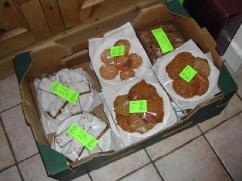 |
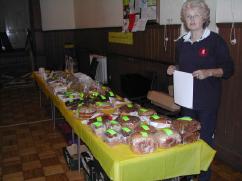 |
 |
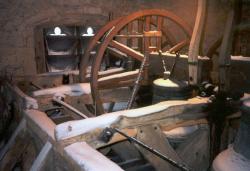 |
| Some of the cakes en route to Brasted's Thursday market | Catherine in selling mode | The photo used for the Christmas card which sold 5000 | The photo used for the slightly less successful second edition |
By now it seemed to be downhill all the way, except that the campaign chairman spent a few months carefully tending a spreadsheet and watching the expenditure needed and the cash available gently converging. The order was placed, the installation of the steelwork to carry the new frames was organised, and all we had to do was wait for the jobs to be scheduled. Some of the locals dismantled all the fittings in early February 2005 and the KCACR BRF gang turned up the following week to take the bells out. A party visited Whitechapel in March to see the casting of the new trebles, and all eight came back to Brasted in the first week in May, preceded by the new frame.
Hanging a few bells in an existing frame and adding a couple more pits to accommodate two new bells sounds a pretty simple task: having been what was charmingly described as the "fit, able-bodied assistance" to the bellhangers on the Brasted project for five weeks I can assure readers that this assumption is naïve in the extreme! On 19 April, the bells still being at Whitechapel, the first operation was to lift and install the steelwork for the new frame. We were grateful for the help of a ringer from a neighbouring village for part of this operation, which involved hauling around half a ton of steel 60 feet up the tower, aligning it in the holes already cut in the walls by the builders, and tightening up some 200 very large nuts and bolts — big boy's Meccano, it was dubbed by some wag. Just multiply your old 4BAs by a factor of around 8 and you have an idea of what was involved. Once all this was done, the builders came back and filled in the holes and secured the steels for us. We later discovered that they'd not made an especially good job of clearing up the chunks of stone excavated from the holes, and we are still having the odd descent of rubble as the bells are rung.
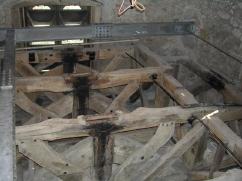 |
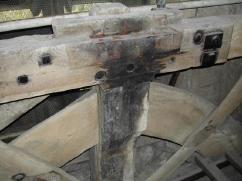 |
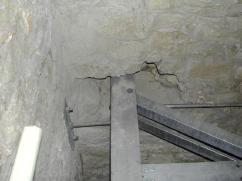 |
 |
| The empty 16th century frame (two of the new RSJs may be seen on the left and in the background) | More detail of the ancient frame | RSJ in place before grouting | Some of the 40 tierods |
On 2 May, work started in earnest on preparing the old frame for the new fittings, with twelve new slots being cut into the timber to house the new bearing plates (we're talking about chiselling oak to a depth of about an inch and about 2 by 9 inches in area, so this is no mean feat). Everything has to be absolutely level in every direction, of course. While this was going on, the 40 new tierods to secure the frame were being installed. These rods are around 5 feet long and about three-quarters of an inch in diameter and seemingly weigh a ton apiece (slight poetic licence here, but by the time one gets to tierod number 37 or so, a little latitude is permissible).
Eventually most, but by no means all, of the preparatory work was done, and the bells returned from Whitechapel on 9 May. Lifting them up to the bellchamber was a fairly slow process, governed to a great extent by the amount of room there was to manoeuvre each bell once it reached the top. For instance five and six, being in the new frames, had to be shoehorned into position before completion of their frames could begin. The next couple of weeks were spent hanging the bells and aligning bearings etc — this had to be done in conjunction with frame tightening using the new tierods, which caused a few headaches at times. Then came all those unexciting but essential niceties like pulleys, stays and sliders, which help to make ringing so much easier, but do take a devil of a time to fit.
 |
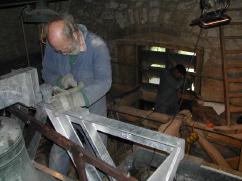 |
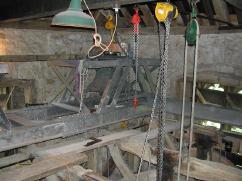 |
| The 3rd waiting to be lifted | Assembling the bearings on the 5th | The 5th is now installed |
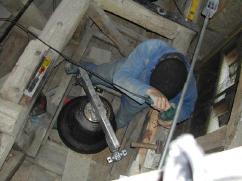 |
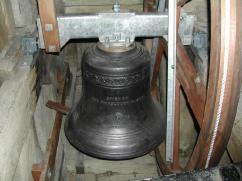 |
 |
| Fitting the bearing plates for the treble | The new treble in place . . . | . . . and the 2nd |
However, despite your scribe becoming a grandfather, attending the Central Council meeting, and generally being a pain to everyone, all was declared OK for a tryout on 2 June, followed by our first 8-bell practice the following evening. The dedication on 12 June was attended by a full congregation of parishioners and ringers from near and far, and all who took part in the ringing on that morning felt that the job had been a great success, with both the go and the sound of the bells being a more than somewhat improvement on the previous installation.
Saying a mere "thank you" to all those involved with this project over the past two and a half years seems a bit inadequate, but thank you all the same.
The first quarter on the eight included many people who'd made a substantial contribution to the fundraising project.
| Brasted, St Martin, 2 October 2005
1260 Grandsire Triples |
|
| Annie Brook (first on 8) | Treble |
| Tessa Worthington | 2 |
| Astrid Fairclough | 3 |
| Eric Roughley | 4 |
| Bobbie Fairclough (first on 8 inside) | 5 |
| Catherine Lewis (C) | 6 |
| Anthony Leeves | 7 |
| Frank Lewis | Tenor |
First quarter on the newly augmented 8. Wedding compliment to David Arnold and Nicola Murkin, daughter of Patricia and mother of Ella, both Brasted ringers. |
|
By the way, for those interested in such things, the tenor now weighs in at a rather slimmer 9-2-2 and its note is G flat (fuller details on The Church Bells of Kent website). And, yes, we're still widdershins and proud of it. A short video of some of the working, including the casting of the new treble, is available from Meadowbank Productions, and brief excerpts are viewable by clicking here (you'll need Quicktime to make this work).
